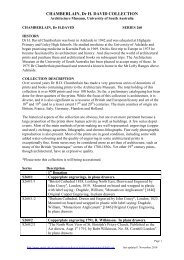GALLERY - University of South Australia
GALLERY - University of South Australia
GALLERY - University of South Australia
Create successful ePaper yourself
Turn your PDF publications into a flip-book with our unique Google optimized e-Paper software.
Digital Phantoms: A Reality Check. Dr Anne Marsh<br />
When Juliana Engberg directed the first Biennial <strong>of</strong> Contemporary Art<br />
in Melbourne (1999) she became famous for saying that “video was the<br />
tapestry <strong>of</strong> the twenty-first century”. The idea seemed to resonate with<br />
artists and the public alike and it is a way <strong>of</strong> conceptualising photo-based<br />
and electronic media that recognises the history <strong>of</strong> its evolution and<br />
underlines its provenance. There’s always talk about new media and<br />
<strong>of</strong>ten this noise tends to foreclose on history. Making a comparison<br />
between tapestry and video may seem a bit far fetched but what Engberg<br />
was getting at is that these forms <strong>of</strong> art and image making have a popular<br />
appeal, they are also functional and able to be adapted across different<br />
levels <strong>of</strong> skill. Tapestry was both a private, domestic form <strong>of</strong> image<br />
making and a public display <strong>of</strong> virtuoso talent. Today we can say the<br />
same about digital photography which allows the amateur operator to<br />
compete with pr<strong>of</strong>essionals.<br />
Zara Stanhope curated an exhibition at MoMA at Heidi recently – titled<br />
Perfect for Every Occasion: Photography Today – where the everyday<br />
and the street photograph re-surface in recent photo-based practice.<br />
Artists are consistently looking for new ways in which to challenge the<br />
mainstream, and, after a decade or so <strong>of</strong> spectacular, performative<br />
museum-sized photo prints, it comes as no surprise that artists once<br />
again search out the mundane and the ordinary and try to insert some<br />
sort <strong>of</strong> balance. Stanhope introduced her exhibition with a small suite <strong>of</strong><br />
photo-journalist shots - some taken by pr<strong>of</strong>essionals, some by amateurs,<br />
but all reproduced on a very small scale, as if clipped from a magazine.<br />
The artists in Perfect for Every Occasion are not photojournalists nor<br />
social documentary photographers in the traditional sense but many <strong>of</strong><br />
them look to street photography and the art <strong>of</strong> the everyday, including<br />
conceptual art, as a way <strong>of</strong> distancing themselves from performative or<br />
directorial photography.<br />
The accessibility <strong>of</strong> photography to a population <strong>of</strong> producers was<br />
made famous in George Eastman’s advertising slogan for Kodak in the<br />
1880s: “You push the button, we do the rest” became an emblematic<br />
slogan for photography’s utilitarian value. 1 This democratic aspect<br />
<strong>of</strong> the medium makes photography an amateur image making process<br />
which has enormous popular appeal. Although the mass production<br />
<strong>of</strong> millions <strong>of</strong> family snap shots has been analysed as a ‘middle brow art’<br />
by French sociologist Pierre Bourdieu, other critics have expanded on<br />
the psychological aspects <strong>of</strong> the medium that seduce the photographer<br />
and the viewer. 2<br />
There has been an increased interest in amateur photography in recent<br />
times. The most powerful digital images to infiltrate our electronic<br />
networks were the mobile phone camera pictures <strong>of</strong> Iraqi prisoners<br />
being tortured by American soldiers at Abu Ghraib. These images have<br />
shocked the world because we believe them to be true accounts <strong>of</strong> what<br />
happened. No amount <strong>of</strong> postmodern theory is going to convince us that<br />
these are inauthentic copies without an original experience.<br />
The digital age brings with it the potential to manipulate and invent<br />
images in new ways, using various s<strong>of</strong>tware packages and electronic<br />
interfaces to produce fantastic results. This world <strong>of</strong> fantasy and the<br />
phantasmagorical has a long and spectacular history that begins when<br />
people first started to gaze at the stars.<br />
Walter Benjamin suggests that the history <strong>of</strong> photography begins when<br />
people start to interpret the configurations <strong>of</strong> the night sky. 3 When they<br />
see pictures written in light. For Benjamin, “reading – and therefore the<br />
possibility <strong>of</strong> knowledge in general – begins in the reading <strong>of</strong> stars.” 4<br />
This is a compelling metaphor that propels Benjamin into meditations<br />
on philosophy and history. All reading and writing is interpretation, all<br />
languages are synthetic systems <strong>of</strong> one sort or another. What Benjamin<br />
and a host <strong>of</strong> artists are interested in is the mysterious side <strong>of</strong> this process.<br />
This is not to say that this is an a-political desire, on the contrary, it is a<br />
dialectical thinking that acknowledges that modes <strong>of</strong> mechanical and<br />
technological reproduction change the way in which ideology thinks<br />
and seduces. The phantasmagoria <strong>of</strong> modernity and post-modernity<br />
(shopping malls, advertising, the World Wide Web, photography, film,<br />
computer games and virtual worlds) enmesh the subject/spectator within<br />
a sophisticated techno-psychological experience, one in which the real has<br />
already become a simulacra. 5<br />
The most positive outcome <strong>of</strong> this era is that the subject/spectator<br />
becomes increasingly involved as an active participant, choosing and<br />
selecting one form or idea over another—supporting both established<br />
stereotypes and sub-cultural identities. For Benjamin, like the Surrealists,<br />
it was a matter <strong>of</strong> harnessing the powers <strong>of</strong> the phantasmagoria to the<br />
revolutionary struggle; using the phantasmagorical and dream elements<br />
to precipitate dialectical thinking.<br />
The meeting <strong>of</strong> art and science within mechanical and digital forms <strong>of</strong><br />
representation produces a discourse that is rich and multi-layered. On one<br />
hand analogue photography promised (scientifically) to reproduce what<br />
was in front <strong>of</strong> the camera’s lens. The photograph was to be an index <strong>of</strong><br />
7


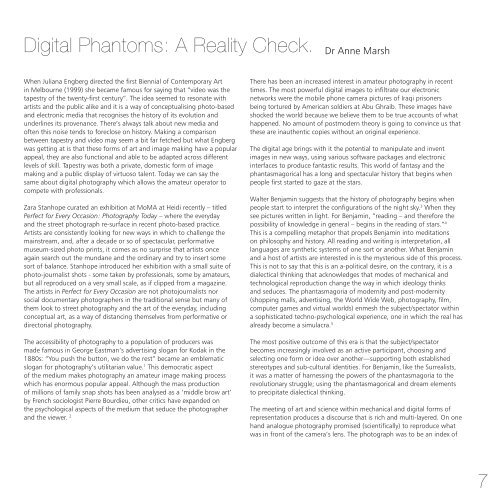
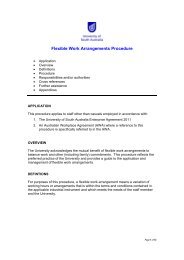
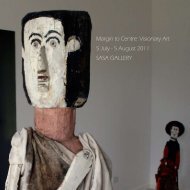


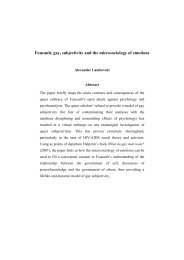

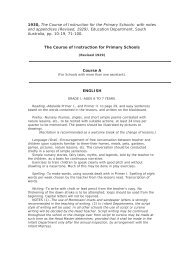
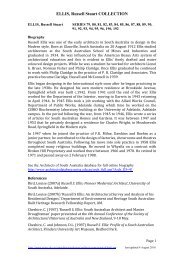

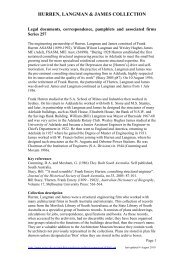
!['The Asian Delegation Chooses […] the Wu-Tang Clan!'—](https://img.yumpu.com/7767765/1/184x260/the-asian-delegation-chooses-the-wu-tang-clan.jpg?quality=85)

